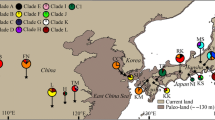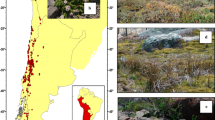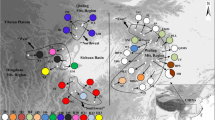Abstract
Botrychium s.s. is a cosmopolitan fern genus comprising about 35 currently recognized species. Despite unexpected high genetic diversity recently highlighted within Botrychium lunaria in the circumboreal region, few studies have included representative samples from Central Europe. Therefore, the aim of this work was to study the phylogeography of B. lunaria in the Central-European Mountain System and to compare it with that of flowering plants. Two noncoding chloroplast regions (psbA-trnH and trnL-F) were sequenced (918 bp) from 87 individuals from 34 populations in the major European mountain chains (Sierra Nevada, Pyrenees, Massif Central, Jura, Vosges, Black Forest, Alps, Apennines, and Carpathians). Among the 24 haplotypes found in the B. lunaria aggregate in Europe, bayesian phylogeny and median-joining network support four main clades (LUN1, LUN2, LUN3, and TUN). NST and GST comparison as well as homogeneous groups indicated by SAMOVA indicate a clear phylogeographical pattern. However, unlinked to geographical distance, genetic diversity is greatest in the Prealps and highlights three main barriers to gene flow: S–N of Central Alps (Aosta-Lepontic Alps), and two separating E–W Alps (Lago di Como-Rhaetian Alps and Dolomites-Noric-Julian Alps). Our results indicate that alpine populations of the B. lunaria aggregate survived the Quaternary glaciations in situ in two main refugia, in the southern and eastern periphery of the Alps. Not only areas with higher values of genetic diversity, but also refugia and sites of geographical boundaries to gene flow, appear similar in both ferns and flowering plants.




Similar content being viewed by others
References
Akaike H (1973) Information theory and an extension of the maximum likelihood principle. In: Petrov BN, Csaki F (eds) Proceedings of the second international symposium on information theory, pp 267–281. Akademiai Kiado, Budapest, Hungary
Barrington DS (1993) Ecological and historical factors in fern biogeography. J Biogeogr 20:275
Bauert MR, Kälin M, Edwards PJ, Baltisberger M (2007) Genetic structure and phylogeography of alpine relict populations of Ranunculus pygmaeus and Saxifraga cernua. Bot Helv 117:181–196
Bettin O, Cornejo C, Edwards PJ, Holderegger R (2007) Phylogeography of the high alpine plant Senecio halleri (Asteraceae) in the European Alps: in situ glacial survival with postglacial stepwise dispersal into peripheral areas. Mol Ecol 16:2517–2524
Birks HJB (1976) The distribution of European pteridophytes: a numerical analysis. New Phytol 77:257–287
Brockmann-Jerosch H, Brockmann-Jerosch M (1926) Die Geschichte der Schweizerischen Alpen-flora. In: Schröter C (ed) Das Pflanzenleben der Alpen. Raustein, Zürich, pp 1110–1215
Bystriakova N, Ansell SW, Russell SJ, Grundmann M, Vogel JC, Schneider H (2014) Present, past and future of the European rock fern Asplenium fontanum: combining distribution modelling and population genetics to study the effect of climate change on geographic range and genetic diversity. Ann Bot 113:453–465
Chodat R, Pampanini R (1902) Sur la distribution des plantes des Alpes austro-orientales et plus particulièrement d’un choix déplantés des Alpes cadoriques et vénitiennes. Globe Rev Genevoise Géographie 41:63–132
Comes HP, Kadereit JW (1998) The effect of quaternary climatic changes on plant distribution and evolution. Trends Plant Sci 3:432–438
Dauphin B, Farrar DR, Maccagni A, Grant JR (in press) A worldwide molecular phylogeny provides new insight on cryptic diversity within the moonworts (Botrychium s.s., Ophioglossaceae). Syst Bot
Dauphin B, Vieu J, Grant JR (2014) Molecular phylogenetics supports widespread cryptic species in moonworts (Botrychium s.s., Ophioglossaceae). Am J Bot 101:128–140
Doyle JJ, Doyle JL (1987) A rapid DNA isolation procedure for small quantities of fresh leaf tissue. Phytochem Bull 19:11–15
Dupanloup I, Schneider S, Excoffier L (2002) A simulated annealing approach to define the genetic structure of populations. Mol Ecol 11:2571–2581
Ehlers J, Gibbard PL (2008) Quaternary glaciations: extent and chronology. Development in quaternary science, vol 2. CD. Elsevier, Amsterdam
Farrar DR (1998) Population genetics of moonwort Botrychium. In: Berlin N, Miller P, Borovansky J, Seal US, Byers O (eds) Population and habitat viability assessment for the goblin fern (Botrychium mormo), pp 109–113. Final Report. The Conservation Breeding Specialist Group, Apple Valley, Minnesota, USA
Farrar DR (2011) Systematics and taxonomy of genus Botrychium. http://www.public.iastate.edu/~herbarium/botrychium/Moonwort-Systematics.pdf
Finsinger W, Tinner W (2007) Pollen and plant macrofossils at Lac de Fully (2135 m asl): Holocene forest dynamics on a highland plateau in the Valais, Switzerland. Holocene 17:1119–1127
Hauk WD, Haufler CH (1999) Isozyme variability among cryptic species of Botrychium subgenus Botrychium (Ophioglossaceae). Am J Bot 86:614–633
Hauk WD, Kennedy L, Hawke HM (2012) A phylogenetic investigation of Botrychium s.s. (Ophioglossaceae): evidence from three plastid DNA sequence datasets. Syst Bot 37:320–330
Hewitt GM (2004) Genetic consequences of climatic oscillations in the Quaternary. Philos Trans R Soc Lond B Biol Sci 359:183–195
Holderegger R, Thiel-Egenter C, Parisod C (2011) Marie Brockmann-Jerosch and her influence on alpine phylogeography. Alp Bot 121:5–10
Hudson RR, Slatkin M, Maddison WP (1992) Estimation of levels of gene flow from DNA sequence data. Genetics 132:583–589
Hunt HV, Ansell SW, Russell SJ et al (2009) Genetic diversity and phylogeography in two diploid ferns, Asplenium fontanum subsp. fontanum and A. petrarchae subsp. bivalens, in the western Mediterranean. Mol Ecol 18:4940–4954
Ivy-Ochs S (2015) Glacier variations in the European Alps at the end of the last glaciation. Cuad Investig Geogr 41:295–315
Manni F, Guerard E, Heyer E (2004) Geographic patterns of (genetic, morphologic, linguistic) variation: how barriers can be detected by using Monmonier’s algorithm. Hum Biol 76:173–190
Mantel N (1967) The detection of disease clustering and a generalized regression approach. Cancer Res 27:209–220
Marazzi S (2005) Atlante orografico delle Alpi: SOIUSA: suddivisione orografica internazionale unificata del sistema alpino. Priuli & Verlucca, Pavone Canavese (Torino)
Merxmüller H (1952) Untersuchungen zur Sippengliederung und Arealbildung in den Alpen. Verein zum Schutze der Alpenpflanzen und -Tiere 17:96–133
Monmonier MS (1973) Maximum-difference barriers: an alternative numerical regionalization method. Geogr Anal 5:245–261
Nei M (1987) Molecular evolutionary genetics. Columbia University Press, New York
Ozenda P (2002) Perspectives pour une geobiologie des montagnes. Presse polytechniques et universitaires romandes, Lausanne, p. 196
Parisod C (2008) Postglacial recolonisation of plants in the Western Alps of Switzerland. Bot Helv 118:1–12
Parisod C, Besnard G (2007) Glacial in situ survival in the Western Alps and polytopic autopolyploidy in Biscutella laevigata L. (Brassicaceae). Mol Ecol 16:2755–2767
Petit RJ, Csaikl UM, Bordács S et al (2002) Chloroplast DNA variation in European white oaks: phylogeography and patterns of diversity based on data from over 2600 populations. For Ecol Manag 156:5–26
Petit RJ, Aguinagalde I, de Beaulieu J-L et al (2003) Glacial refugia: hotspots but not melting pots of genetic diversity. Science 300:1563–1565
Pons O, Petit RJ (1995) Estimation, variance and optimal sampling of gene diversity: I. Haploid locus. Theor Appl Genet 90:462–470
Pons O, Petit RJ (1996) Measwring and testing genetic differentiation with ordered versus unordered alleles. Genetics 144:1237–1245
Posada D (2008) jModelTest: phylogenetic model averaging. Mol Biol Evol 25:1253–1256
Posada D, Crandall KA (2001) Intraspecific gene genealogies: trees grafting into networks. Trends Ecol Evol 16:37–45
Ronikier M, Schneeweiss GM, Schönswetter P (2012) The extreme disjunction between Beringia and Europe in Ranunculus glacialis sl (Ranunculaceae) does not coincide with the deepest genetic split—a story of the importance of temperate mountain ranges in arctic–alpine phylogeography. Mol Ecol 21:5561–5578
Sang T, Crawford D, Stuessy T (1997) Chloroplast DNA phylogeny, reticulate evolution, and biogeography of Paeonia (Paeoniaceae). Am J Bot 84:1120
Schönswetter P, Tribsch A, Barfuss M, Niklfeld H (2002) Several Pleistocene refugia detected in the high alpine plant Phyteuma globulariifolium Sternb. & Hoppe (Campanulaceae) in the European Alps. Mol Ecol 11:2637–2647
Schönswetter P, Paun O, Tribsch A, Niklfeld H (2003) Out of the Alps: colonization of northern Europe by East Alpine populations of the glacier buttercup Ranunculus glacialis L. (Ranunculaceae). Mol Ecol 12:3373–3381
Schönswetter P, Stehlik I, Holderegger R, Tribsch A (2005) Molecular evidence for glacial refugia of mountain plants in the European Alps. Mol Ecol 14:3547–3555
Smouse P (1998) To tree or not to tree. Mol Ecol 7:399–412
Stehlik I (2000) Nunataks and peripheral refugia for alpine plants during quaternary glaciation in the middle part of the Alps. Bot Helv 110:25–30
Stehlik I (2002) Glacial history of the alpine herb Rumex nivalis (Polygonaceae): a comparison of common phylogeographic methods with nested clade analysis. Am J Bot 89:2007–2016
Stehlik I, Schneller JJ, Bachmann K (2001) Resistance or emigration: response of the high-alpine plant Eritrichium nanum (L.) Gaudin to the ice age within the Central Alps. Mol Ecol 10:357–370
Stensvold M (2008) A taxonomic and phylogeographic study of the Botrychium lunaria complex. Ph.D. Dissertation, Iowa State University, USA
Stensvold MC, Farrar DR (2017) Genetic diversity in the worldwide Botrychium lunaria (Ophioglossaceae) complex, with new species and new combinations. Brittonia. doi:10.1007/s12228-016-9455-z (Printed online 13 December 2016)
Taberlet P, Gielly L, Pautou G, Bouvet J (1991) Universal primers for amplification of three non-coding regions of chloroplast DNA. Plant Mol Biol 17:1105–1109
Taberlet P, Fumagalli L, Wust-Saucy AG, Cosson JF (1998) Comparative phylogeography and postglacial colonization routes in Europe. Mol Ecol 7:453–464
Taberlet P, Zimmermann NE, Englisch T et al (2012) Genetic diversity in widespread species is not congruent with species richness in alpine plant communities. Ecol Lett 15:1439–1448
Tate JA, Simpson BB (2003) Paraphyly of Tarasa (Malvaceae) and diverse origins of the polyploid species. Syst Bot 28:723–737
The Pteridophyte Phylogeny Group. (PPG1) (2016) A community-derived classification for extant lycophytes and ferns. J Syst Evol 54(6):563–603
Thiel-Egenter C, Alvarez N, Holderegger R et al (2011) Break zones in the distributions of alleles and species in alpine plants. J Biogeogr 38:772–782
Trewick SA, Morgan-Richards M, Russell SJ et al (2002) Polyploidy, phylogeography and Pleistocene refugia of the rockfern Asplenium ceterach: evidence from chloroplast DNA. Mol Ecol 11:2003–2012
Tribsch A, Schönswetter P (2003) Patterns of endemism and comparative phylogeography confirm palaeo-environmental evidence for Pleistocene refugia in the Eastern Alps. Taxon 52:477–497
Tribsch A, Schönswetter P, Stuessy TF (2002) Saponaria pumila (Caryophyllaceae) and the ice age in the European Alps. Am J Bot 89:2024–2033
Vogel JC, Rumsey FJ, Schneller JJ et al (1999) Where are the glacial refugia in Europe? Evidence from pteridophytes. Biol J Linn Soc 66:23–37
Williams EW, Waller DM (2012) Phylogenetic placement of species within the genus Botrychium ss (Ophioglossaceae) on the basis of plastid sequences, amplified fragment length polymorphisms, and flow cytometry. Int J Plant Sci 173:516–531
Winkler M, Tribsch A, Schneeweiss GM et al (2012) Tales of the unexpected: phylogeography of the arctic-alpine model plant Saxifraga oppositifolia (Saxifragaceae) revisited. Mol Ecol 21:4618–4630
Winther JL, Friedman WE (2007) Arbuscular mycorrhizal symbionts in Botrychium (Ophioglossaceae). Am J Bot 94:1248–1255
Wohlgemut T (2002) Alpine plant species richness in the Swiss Alps: diversity hot spots reconsidered. Mém. Soc. Bot. Genève 3:63–74
Acknowledgements
This work was supported by the Fonds des donations of the Université de Neuchâtel. We would like to thank collectors of material: Amadej Trnkoczy (Triglavski, Slovenia), Benjamin Dauphin (Sierra Nevada, Spain), Claudia Danau (Retezat, Romania), Daniel Sandoz and Frédéric A. Sandoz (Dôle, Switzerland), Jozsef Sulyok (Nagy-mezo, Hungary), and Michela N. Meier. We also want to thank Olivier Bachmann and Julien Vieu for their support in the lab and two anonymous reviewers for their insightful comments on the manuscript.
Declaration of authorship
AM and JRG conceived and designed the research. AM conducted the field- and lab-work. AM and CP analyzed the data. All authors contributed to writing and approved the manuscript.
Author information
Authors and Affiliations
Corresponding author
Ethics declarations
Conflict of interest
The authors declare that they have no conflict of interest.
Electronic supplementary material
Below is the link to the electronic supplementary material.
Rights and permissions
About this article
Cite this article
Maccagni, A., Parisod, C. & Grant, J.R. Phylogeography of the moonwort fern Botrychium lunaria (Ophioglossaceae) based on chloroplast DNA in the Central-European Mountain System. Alp Botany 127, 185–196 (2017). https://doi.org/10.1007/s00035-017-0188-8
Received:
Accepted:
Published:
Issue Date:
DOI: https://doi.org/10.1007/s00035-017-0188-8




